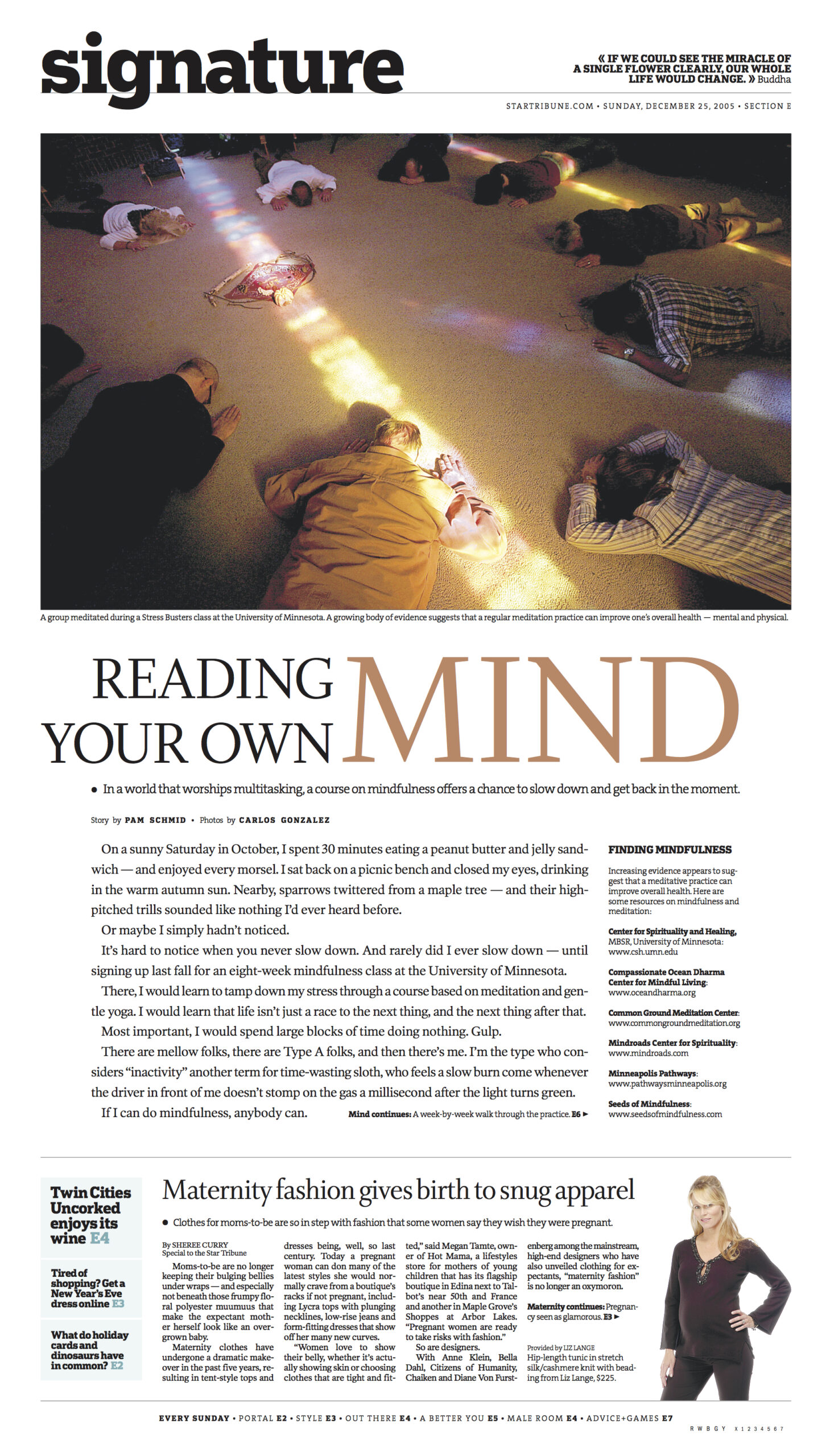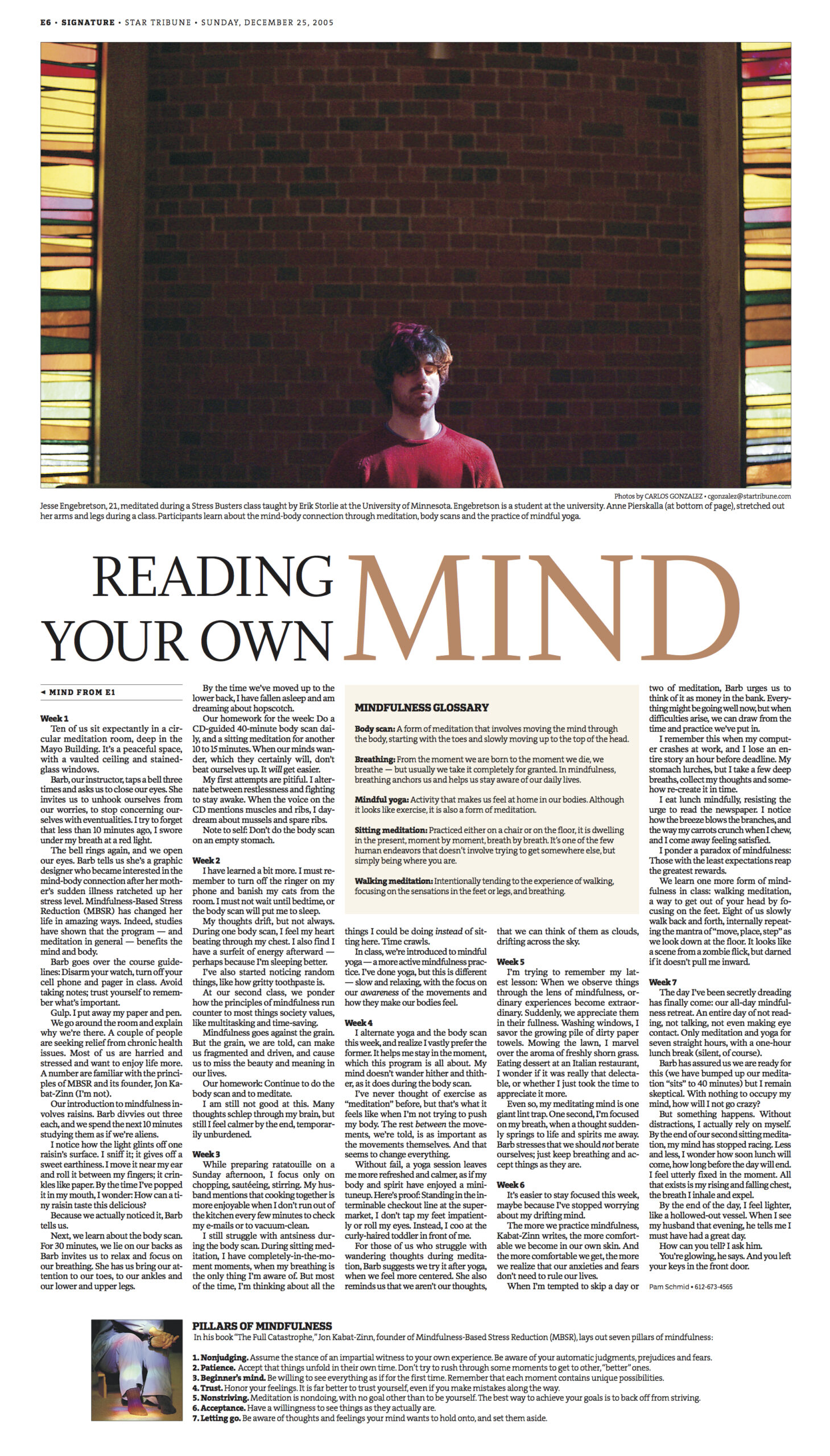Reading Your Own Mind
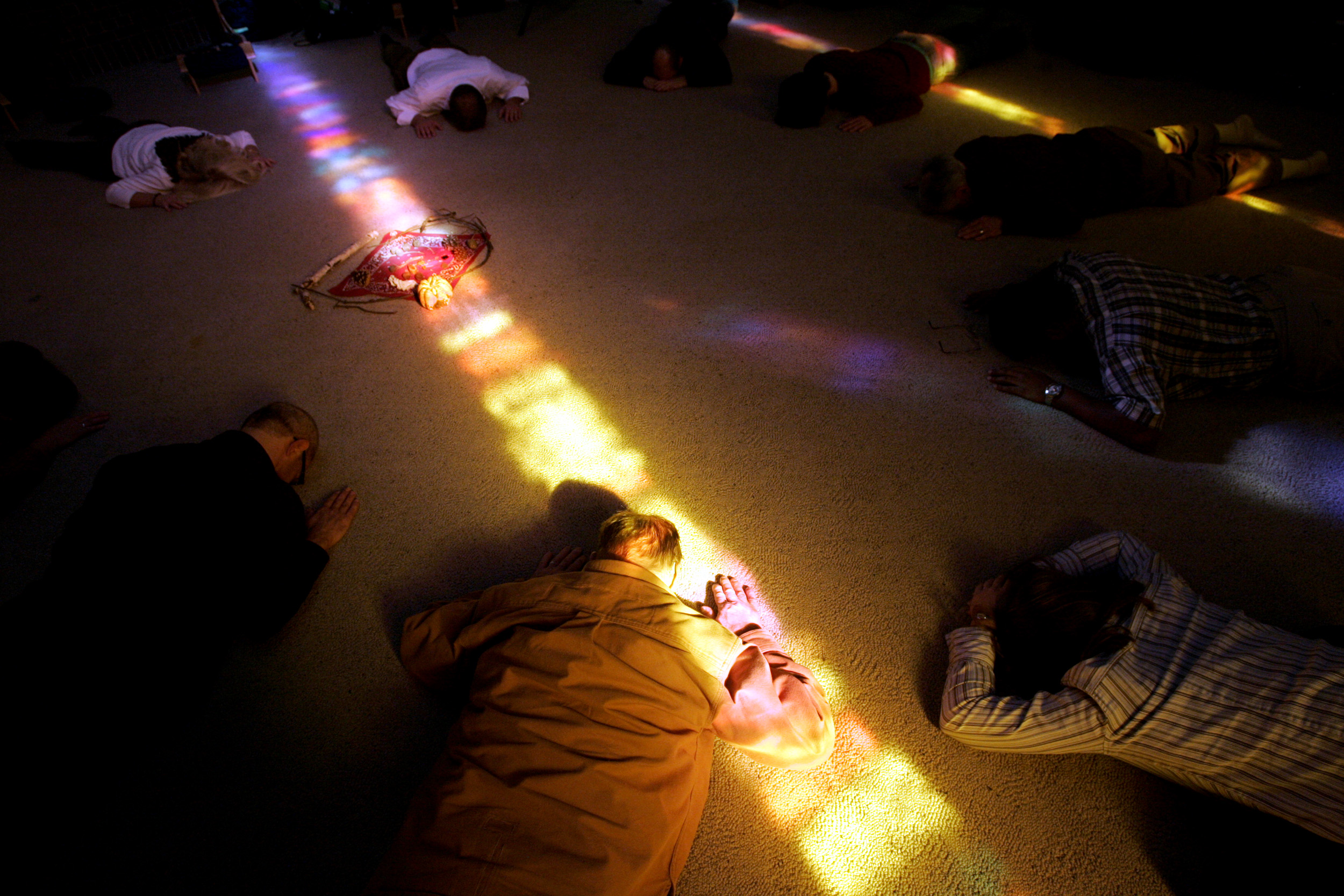
Credit: Carlos Gonzalez, Star Tribune
In a world that worships multitasking, a course on mindfulness offers a chance to slow down and get back in the moment.
On a sunny Saturday in October, I spent 30 minutes eating a peanut butter and jelly sandwich — and enjoyed every morsel. I sat back on a picnic bench and closed my eyes, drinking in the warm autumn sun. Nearby, sparrows twittered from a maple tree — and their high-pitched trills sounded like nothing I’d ever heard before.
Or maybe I simply hadn’t noticed.
It’s hard to notice when you never slow down. And rarely did I ever slow down — until signing up last fall for an eight-week mindfulness class at the University of Minnesota.
There, I would learn to tamp down my stress through a course based on meditation and gentle yoga. I would learn that life isn’t just a race to the next thing, and the next thing after that.
Most important, I would spend large blocks of time doing nothing. Gulp.
There are mellow folks, there are Type A folks, and then there’s me. I’m the type who considers “inactivity” another term for time-wasting sloth, who feels a slow burn come whenever the driver in front of me doesn’t stomp on the gas a millisecond after the light turns green.
If I can do mindfulness, anybody can.
Week 1
Ten of us sit expectantly in a circular meditation room, deep in the Mayo Building. It’s a peaceful space, with a vaulted ceiling and stained-glass windows.
Barb, our instructor, taps a bell three times and asks us to close our eyes. She invites us to unhook ourselves from our worries, to stop concerning ourselves with eventualities. I try to forget that less than 10 minutes ago, I swore under my breath at a red light.
The bell rings again, and we open our eyes. Barb tells us she’s a graphic designer who became interested in the mind-body connection after her mother’s sudden illness ratcheted up her stress level. Mindfulness-Based Stress Reduction (MBSR) has changed her life in amazing ways. Indeed, studies have shown that the program — and meditation in general — benefits the mind and body.
Barb goes over the course guidelines: Disarm your watch, turn off your cell phone and pager in class. Avoid taking notes; trust yourself to remember what’s important.
Gulp. I put away my paper and pen.
We go around the room and explain why we’re there. A couple of people are seeking relief from chronic health issues. Most of us are harried and stressed and want to enjoy life more. A number are familiar with the principles of MBSR and its founder, Jon Kabat-Zinn (I’m not).
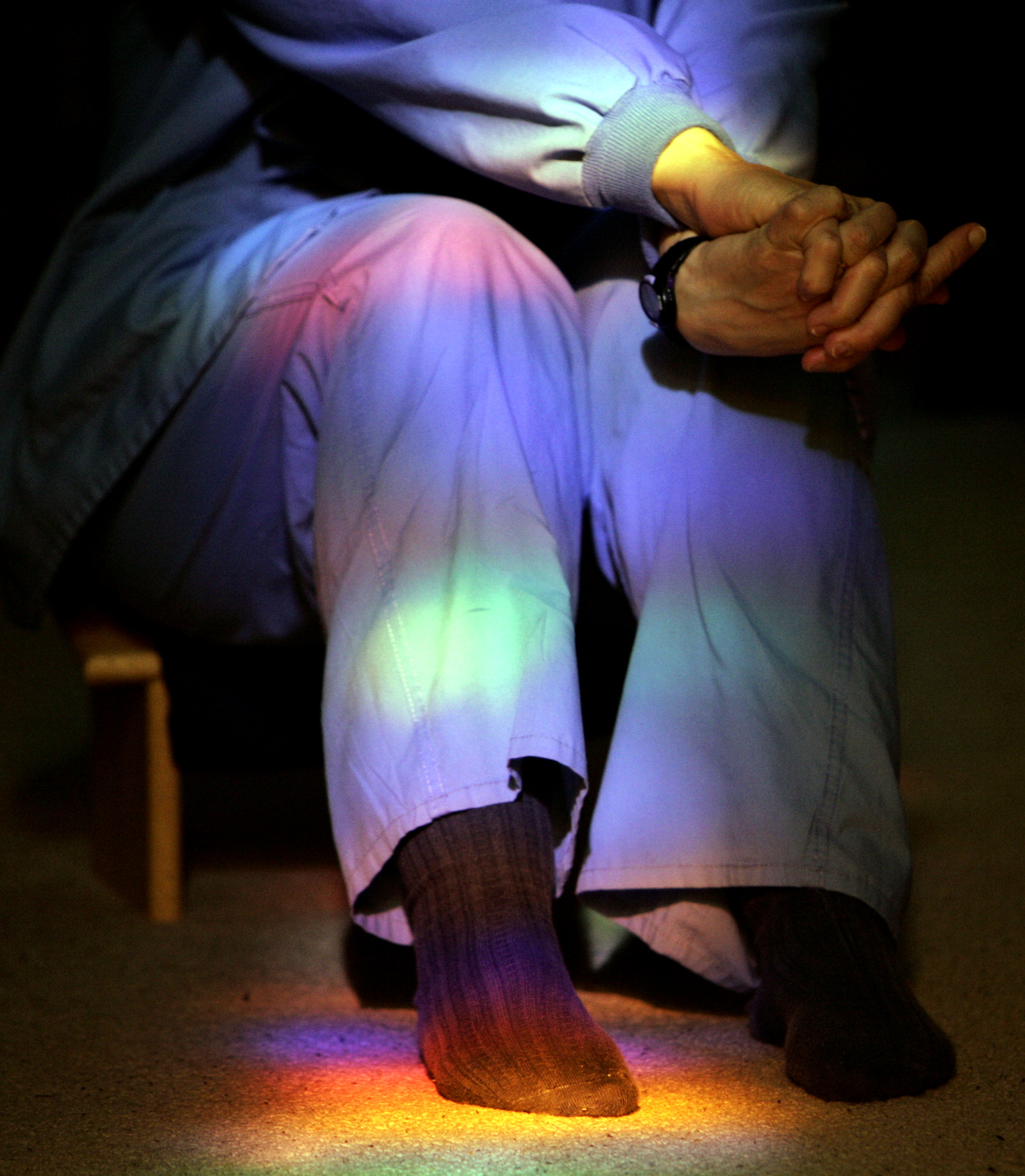
Credit: Carlos Gonzalez, Star Tribune
Our introduction to mindfulness involves raisins. Barb divvies out three each, and we spend the next 10 minutes studying them as if we’re aliens.
I notice how the light glints off one raisin’s surface. I sniff it; it gives off a sweet earthiness. I move it near my ear and roll it between my fingers; it crinkles like paper. By the time I’ve popped it in my mouth, I wonder: How can a tiny raisin taste this delicious?
Because we actually noticed it, Barb tells us.
Next, we learn about the body scan. For 30 minutes, we lie on our backs as Barb invites us to relax and focus on our breathing. She has us bring our attention to our toes, to our ankles and our lower and upper legs.
By the time we’ve moved up to the lower back, I have fallen asleep and am dreaming about hopscotch.
Our homework for the week: Do a CD-guided 40-minute body scan daily, and a sitting meditation for another 10 to 15 minutes. When our minds wander, which they certainly will, don’t beat ourselves up. It will get easier.
My first attempts are pitiful. I alternate between restlessness and fighting to stay awake. When the voice on the CD mentions muscles and ribs, I daydream about mussels and spare ribs.
Note to self: Don’t do the body scan on an empty stomach.
Week 2
I have learned a bit more. I must remember to turn off the ringer on my phone and banish my cats from the room. I must not wait until bedtime, or the body scan will put me to sleep.
My thoughts drift, but not always. During one body scan, I feel my heart beating through my chest. I also find I have a surfeit of energy afterward — perhaps because I’m sleeping better.
I’ve also started noticing random things, like how gritty toothpaste is.
At our second class, we ponder how the principles of mindfulness run counter to most things society values, like multitasking and time-saving.
Mindfulness goes against the grain. But the grain, we are told, can make us fragmented and driven, and cause us to miss the beauty and meaning in our lives.
Our homework: Continue to do the body scan and to meditate.
I am still not good at this. Many thoughts schlep through my brain, but still I feel calmer by the end, temporarily unburdened.
Week 3
While preparing ratatouille on a Sunday afternoon, I focus only on chopping, sauteeing, stirring. My husband mentions that cooking together is more enjoyable when I don’t run out of the kitchen every few minutes to check my e-mails or to vacuum-clean.
I still struggle with antsiness during the body scan. During sitting meditation, I have completely-in-the-moment moments, when my breathing is the only thing I’m aware of. But most of the time, I’m thinking about all the things I could be doing instead of sitting here. Time crawls.
In class, we’re introduced to mindful yoga — a more active mindfulness practice. I’ve done yoga, but this is different — slow and relaxing, with the focus on our awareness of the movements and how they make our bodies feel.
Week 4
I alternate yoga and the body scan this week, and realize I vastly prefer the former. It helps me stay in the moment, which this program is all about. My mind doesn’t wander hither and thither, as it does during the body scan.
I’ve never thought of exercise as “meditation” before, but that’s what it feels like when I’m not trying to push my body. The rest between the movements, we’re told, is as important as the movements themselves. And that seems to change everything.
Without fail, a yoga session leaves me more refreshed and calmer, as if my body and spirit have enjoyed a mini-tuneup. Here’s proof: Standing in the interminable checkout line at the supermarket, I don’t tap my feet impatiently or roll my eyes. Instead, I coo at the curly-haired toddler in front of me.
For those of us who struggle with wandering thoughts during meditation, Barb suggests we try it after yoga, when we feel more centered. She also reminds us that we aren’t our thoughts, that we can think of them as clouds, drifting across the sky.
Week 5
I’m trying to remember my latest lesson: When we observe things through the lens of mindfulness, ordinary experiences become extraordinary. Suddenly, we appreciate them in their fullness. Washing windows, I savor the growing pile of dirty paper towels. Mowing the lawn, I marvel over the aroma of freshly shorn grass. Eating dessert at an Italian restaurant, I wonder if it was really
that delectable, or whether I just took the time to appreciate it more.
Even so, my meditating mind is one giant lint trap. One second, I’m focused on my breath, when a thought suddenly springs to life and spirits me away. Barb stresses that we should not berate ourselves; just keep breathing and accept things as they are.
Week 6
It’s easier to stay focused this week, maybe because I’ve stopped worrying about my drifting mind.
The more we practice mindfulness, Kabat-Zinn writes, the more comfortable we become in our own skin. And the more comfortable we get, the more we realize that our anxieties and fears don’t need to rule our lives.
When I’m tempted to skip a day or two of meditation, Barb urges us to think of it as money in the bank. Everything might be going well now, but when difficulties arise, we can draw from the time and practice we’ve put in.
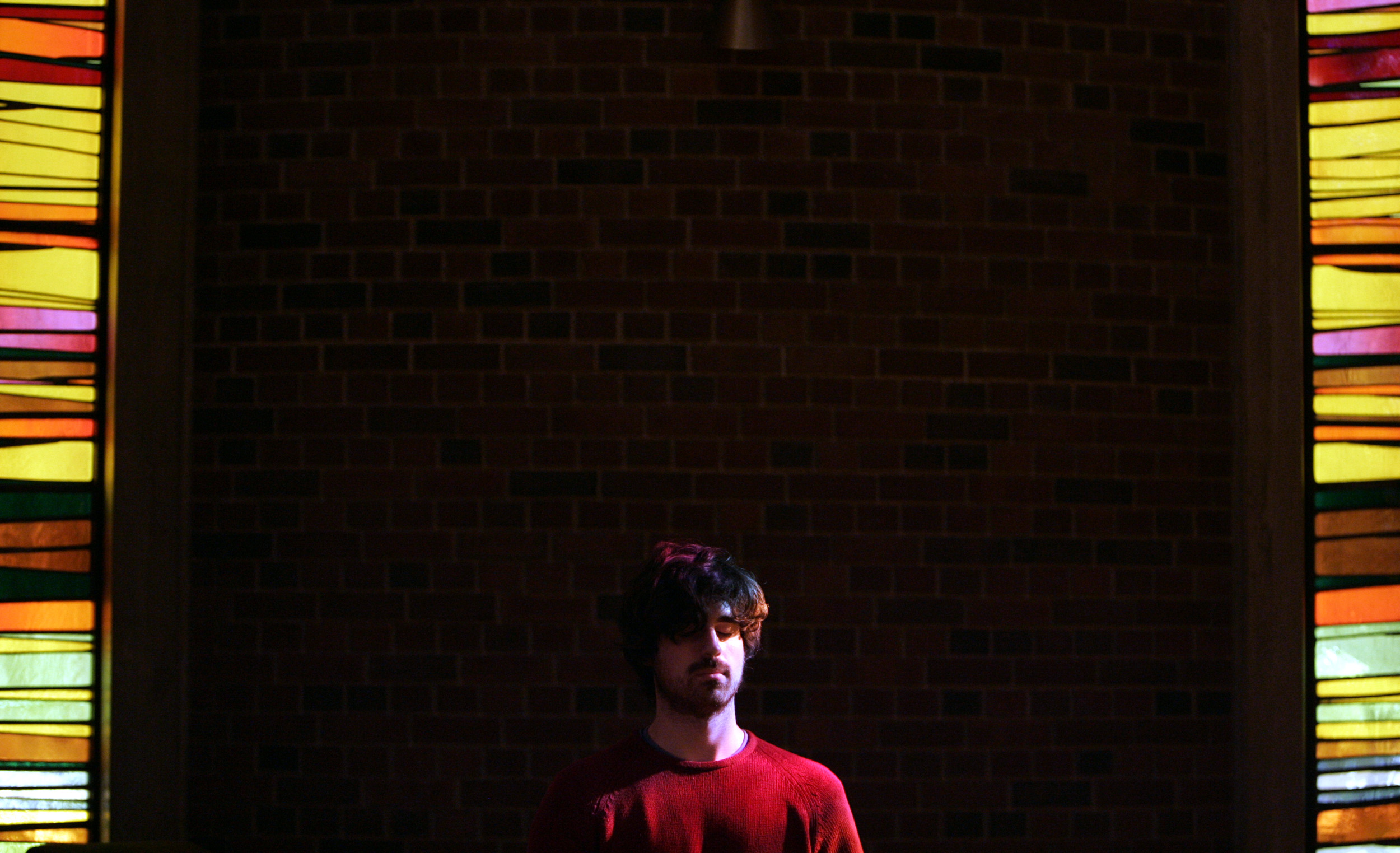 Credit: Carlos Gonzalez, Star Tribune
Credit: Carlos Gonzalez, Star Tribune
I remember this when my computer crashes at work, and I lose an entire story an hour before deadline. My stomach lurches, but I take a few deep breaths, collect my thoughts and somehow re-create it in time.
I eat lunch mindfully, resisting the urge to read the newspaper. I notice how the breeze blows the branches, and the way my carrots crunch when I chew, and I come away feeling satisfied.
I ponder a paradox of mindfulness: Those with the least expectations reap the greatest rewards.
We learn one more form of mindfulness in class: walking meditation, a way to get out of your head by focusing on the feet. Eight of us slowly walk back and forth, internally repeating the mantra of “move, place, step” as we look down at the floor. It looks like a scene from a zombie flick, but darned if it doesn’t pull me inward.
Week 7
The day I’ve been secretly dreading has finally come: our all-day mindfulness retreat. An entire day of not reading, not talking, not even making eye contact. Only meditation and yoga for seven straight hours, with a one-hour lunch break (silent, of course).
Barb has assured us we are ready for this (we have bumped up our meditation “sits” to 40 minutes) but I remain skeptical. With nothing to occupy my mind, how will I not go crazy?
But something happens. Without distractions, I actually rely on myself. By the end of our second sitting meditation, my mind has stopped racing. Less and less, I wonder how soon lunch will come,
how long before the day will end. I feel utterly fixed in the moment. All that exists is my rising and falling chest, the breath I inhale and expel.
By the end of the day, I feel lighter, like a hollowed-out vessel. When I see my husband that evening, he tells me I must have had a great day.
How can you tell? I ask him.
You’re glowing, he says. And you left your keys in the front door.
Finding mindfulness
Increasing evidence appears to suggest that a meditative practice can improve overall health. Here are some resources on mindfulness and meditation:
- Center for Spirituality and Healing, MBSR, University of Minnesota
www.csh.umn.edu - Compassionate Ocean Dharma Center for Mindful Living
www.oceandharma.org - Common Ground Meditation Center
www.commongroundmeditation.org - Mindroads Center for Spirituality
www.mindroads.com - Minneapolis Pathways
www.pathwaysminneapolis.org - Seeds of Mindfulness
www.seedsofmindfulness.com
Pillars of mindfulness
In his book “The Full Catastrophe,” Jon Kabat-Zinn, founder of Mindfulness-Based Stress Reduction (MBSR), lays out seven pillars of mindfulness:
- Nonjudging. Assume the stance of an impartial witness to your own experience. Be aware of your automatic judgments, prejudices and fears.
- Patience. Accept that things unfold in their own time. Don’t try to rush through some moments to get to other, “better” ones.
- Beginner’s mind. Be willing to see everything as if for the first time. Remember that each moment contains unique possibilities.
- Trust. Honor your feelings. It is far better to trust yourself, even if you make mistakes along the way.
- Nonstriving. Meditation is nondoing, with no goal other than to be yourself. The best way to achieve your goals is to back off from striving.
- Acceptance. Have a willingness to see things as they actually are.
- Letting go. Be aware of thoughts and feelings your mind wants to hold onto, and set them aside.
Mindfulness glossary
- Body scan: A form of meditation that involves moving the mind through the body, starting with the toes and slowly moving up to the top of the head.
- Breathing: From the moment we are born to the moment we die, we breathe – but usually we take it completely for granted. In mindfulness, breathing anchors us and helps us stay aware of our daily lives.
- Mindful yoga: Activity that makes us feel at home in our bodies. Although it looks like exercise, it is also a form of meditation.
- Sitting meditation: Practiced either on a chair or on the floor, it is dwelling in the present, moment by moment, breath by breath. It’s one of the few human endeavors that doesn’t involve trying to get somewhere else, but simply being where you are.
- Walking meditation: Intentionally tending to the experience of walking, focusing on the sensations in the feet or legs, and breathing.
